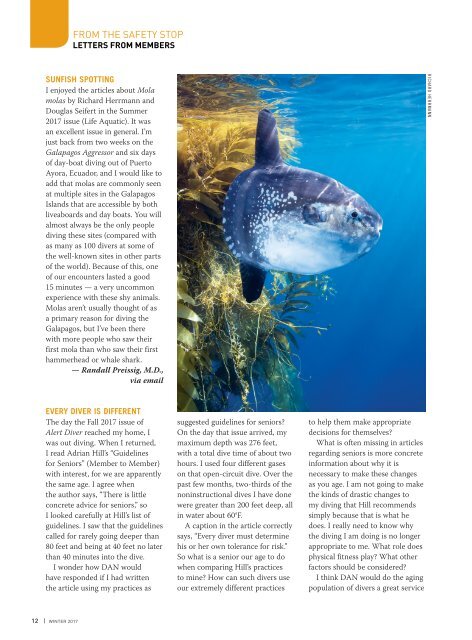AD 2018 Q1
Alert Diver is the dive industry’s leading publication. Featuring DAN’s core content of dive safety, research, education and medical information, each issue is a must-read reference, archived and shared by passionate scuba enthusiasts. In addition, Alert Diver showcases fascinating dive destinations and marine environmental topics through images from the world’s greatest underwater photographers and stories from the most experienced and eloquent dive journalists in the business.
Alert Diver is the dive industry’s leading publication. Featuring DAN’s core content of dive safety, research, education and medical information, each issue is a must-read reference, archived and shared by passionate scuba enthusiasts. In addition, Alert Diver showcases fascinating dive destinations and marine environmental topics through images from the world’s greatest underwater photographers and stories from the most experienced and eloquent dive journalists in the business.
Create successful ePaper yourself
Turn your PDF publications into a flip-book with our unique Google optimized e-Paper software.
FROM THE SAFETY STOP<br />
LETTERS FROM MEMBERS<br />
SUNFISH SPOTTING<br />
I enjoyed the articles about Mola<br />
molas by Richard Herrmann and<br />
Douglas Seifert in the Summer<br />
2017 issue (Life Aquatic). It was<br />
an excellent issue in general. I’m<br />
just back from two weeks on the<br />
Galapagos Aggressor and six days<br />
of day-boat diving out of Puerto<br />
Ayora, Ecuador, and I would like to<br />
add that molas are commonly seen<br />
at multiple sites in the Galapagos<br />
Islands that are accessible by both<br />
liveaboards and day boats. You will<br />
almost always be the only people<br />
diving these sites (compared with<br />
as many as 100 divers at some of<br />
the well-known sites in other parts<br />
of the world). Because of this, one<br />
of our encounters lasted a good<br />
15 minutes — a very uncommon<br />
experience with these shy animals.<br />
Molas aren’t usually thought of as<br />
a primary reason for diving the<br />
Galapagos, but I’ve been there<br />
with more people who saw their<br />
first mola than who saw their first<br />
hammerhead or whale shark.<br />
— Randall Preissig, M.D.,<br />
via email<br />
RICHARD HERRMANN<br />
EVERY DIVER IS DIFFERENT<br />
The day the Fall 2017 issue of<br />
Alert Diver reached my home, I<br />
was out diving. When I returned,<br />
I read Adrian Hill’s “Guidelines<br />
for Seniors” (Member to Member)<br />
with interest, for we are apparently<br />
the same age. I agree when<br />
the author says, “There is little<br />
concrete advice for seniors,” so<br />
I looked carefully at Hill’s list of<br />
guidelines. I saw that the guidelines<br />
called for rarely going deeper than<br />
80 feet and being at 40 feet no later<br />
than 40 minutes into the dive.<br />
I wonder how DAN would<br />
have responded if I had written<br />
the article using my practices as<br />
suggested guidelines for seniors?<br />
On the day that issue arrived, my<br />
maximum depth was 276 feet,<br />
with a total dive time of about two<br />
hours. I used four different gases<br />
on that open-circuit dive. Over the<br />
past few months, two-thirds of the<br />
noninstructional dives I have done<br />
were greater than 200 feet deep, all<br />
in water about 60°F.<br />
A caption in the article correctly<br />
says, “Every diver must determine<br />
his or her own tolerance for risk.”<br />
So what is a senior our age to do<br />
when comparing Hill’s practices<br />
to mine? How can such divers use<br />
our extremely different practices<br />
to help them make appropriate<br />
decisions for themselves?<br />
What is often missing in articles<br />
regarding seniors is more concrete<br />
information about why it is<br />
necessary to make these changes<br />
as you age. I am not going to make<br />
the kinds of drastic changes to<br />
my diving that Hill recommends<br />
simply because that is what he<br />
does. I really need to know why<br />
the diving I am doing is no longer<br />
appropriate to me. What role does<br />
physical fitness play? What other<br />
factors should be considered?<br />
I think DAN would do the aging<br />
population of divers a great service<br />
12 | WINTER 2017









